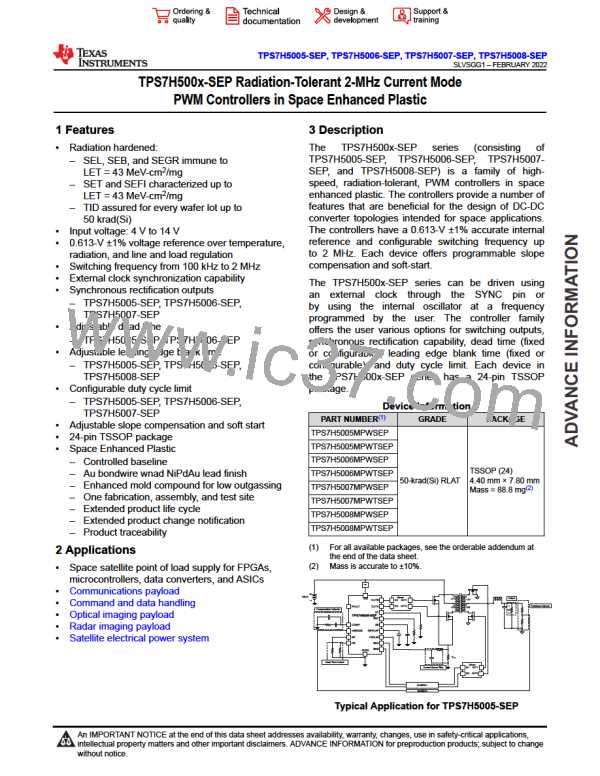TPS7H5005-SEP, TPS7H5006-SEP, TPS7H5007-SEP, TPS7H5008-SEP
www.ti.com
SLVSGG1 – FEBRUARY 2022
1
fzero
=
2 × COUT _BULK × ESRBULK
(66)
(67)
1
fresonant
=
2 × Lf × COUT _BULK
(68)
In the event that there is peaking at high frequencies due to the output filter, a resistor can be used to dampen
this peaking effect. Equation 69 and Equation 70 can be used to determine the frequency of the peaking and the
value of the resistor needed to provide adequate damping.
(69)
(70)
9.2.2.12 Sense Resistor
The converter was designed such that the cycle-by-cycle limiting will begin once the output current reaches
roughly 35 A. Given that the peak inductor current at maximum load current is 24.25 A, this provides about 45%
margin before an overcurrent event is detected by the controller. The primary side current is being sensed at
CS_ILIM, so the turns ratio must be accounted for when calculating the necessary value of the sense resistor.
Likewise, a current sense transformer with turns ratio of 1:100 is used to step down the primary current. The
following calcuations are used to arrive at the value of RCS that translates to the desired output overcurrent level.
NS NCSP
×
ILIM = IL,PEAK
×
NP NCSS
(71)
(72)
1
1
ILIM = 35 A ×
×
= 0.14 A
2.5 100
VCS_ILIM
RCS
=
ILIM
(73)
(74)
1.05 V
0.14 A
RCS
=
= 7.73 Ω
Based on the calculation, a 7.5-Ω resistor was selected for RCS
.
9.2.2.13 Hiccup Capacitor
For the design, the value of the hiccup capacitor used is the minimum recommended value of 3.3 nF. Based on
this value, the delay and hiccup times of the converter after an overcurrent are detected can be calculated.
Copyright © 2022 Texas Instruments Incorporated
Submit Document Feedback
55
Product Folder Links: TPS7H5005-SEP TPS7H5006-SEP TPS7H5007-SEP TPS7H5008-SEP

 TI [ TEXAS INSTRUMENTS ]
TI [ TEXAS INSTRUMENTS ]